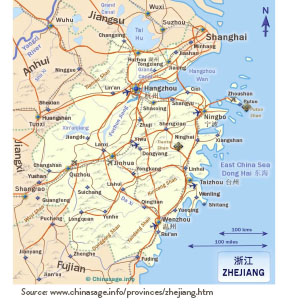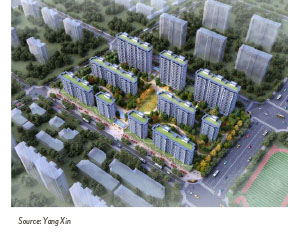From August through October my wife Yang Xin was in China helping to care for her father. Xin lives in Zhoushan, a series of islands off the coast of Zhejiang Province, once remote but now connected by high-speed expressways. Shenjiamen, the principal town of Zhoushan is a prosperous fishing port, a major oil terminal for China, and the home of one of the four holiest Buddhist sites, Putuoshan.
We have apartments both in Shenjiamen and in Hangzhou, where Xin conducts her business (sometimes remotely, sometimes in person). Hangzhou is a very prosperous city of 10 million about half an hour by high-speed train (at 180 mph!) from Shanghai.

Xin brokers furniture fabric from producers in Zhejiang Province to wholesalers in Eastern Europe, principally Poland. It’s a complicated process, sending out samples, securing orders, ensuring the quality of not just one meter but up to 15,000 meters of the same fabric, renting containers and ship space, and meeting tight delivery schedules. Xin often deals with people she has known for years but never met in person. Globalization is a complicated dance, but it works.
Here are some observations I have gleaned from her trip. While the rest of the world is “learning to live with COVID,” China has gone into COVID lockdown. Chinese figures are sometimes suspect, but their statistics show there have been fewer than 5,000 deaths in the country due to the pandemic since early 2020 compared to 750,000 in the US. Quarantining is strict and common. When the container port of Ningbo-Zhoushan, one of the five busiest in the world, reported just one case of Covid recently, the entire port was shut down for several days.
It was difficult and expensive for Xin to travel to China. She quarantined for a total of 21 days upon arrival, the first 14 days in hotels in or near Shanghai, which she paid for herself, and the final seven days at her apartment in Shenjiamen with camera monitors at the door!
After quarantining she carried an app on her phone (as do all Chinese) with a daily code of Green, Yellow or Red. The codes are based on your phone’s GPS. Travel anywhere close to where COVID has occurred, and you might go from Green to Yellow to Red (back to full quarantining!). Your code is constantly checked when you are out in public.
Earlier this year Xin’s biggest business difficulty was obtaining containers and spaces on ships. Prices soared and availability was limited. Now the biggest problem is electricity and keeping factories operating. Part of the problem is a lack of coal for power plants, but the government is also trying to meet global warming standards. Cutting power to high polluting industries like fabric dying achieves two objectives: it reduces pollution and relieves congestion at the ports.

Finally, there is the issue of housing. The biggest and most profitable investment for individuals in China the past twenty years has been property. Developers pre-sell units (at full price upfront) and then deliver the apartments two to three years later. Individuals often own two to four units, one to live in and the others to rent or flip. Xin’s apartment complex in Zhoushan (and these complexes are duplicated throughout China) consists of 12 buildings (see picture) with a total of over 1,100 units housing perhaps 4,000 people. The complex was finished in late 2020. Xin estimates one third of the units are occupied now and another third are being held for investment. In Hangzhou our apartment is near Alibaba’s headquarters (China’s Amazon), and with the problems the company and Jack Ma are having, real estate in that part of the city has gone flat, and commercial rents are down. Letting the air out of the real estate boom gradually to avoid a panic will be Xi Jinping’s big high-wire challenge.